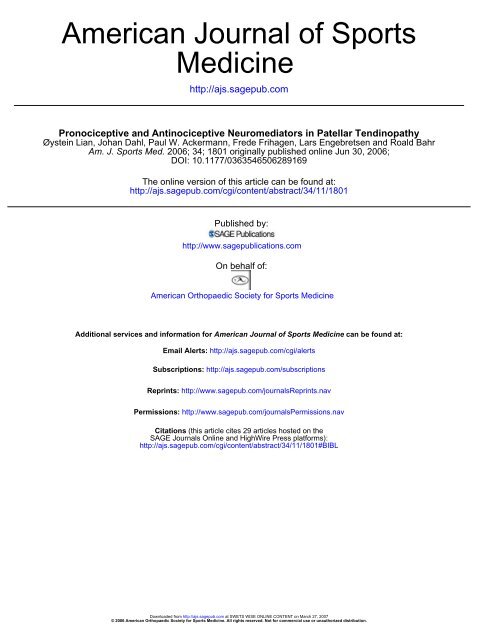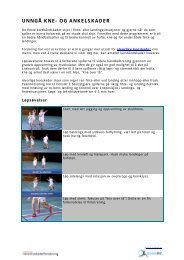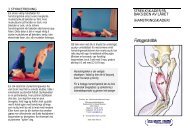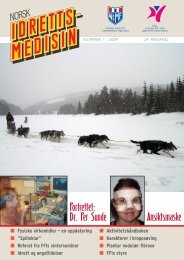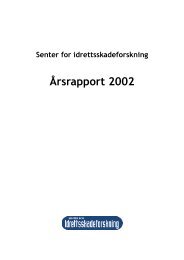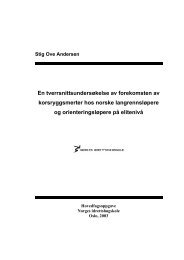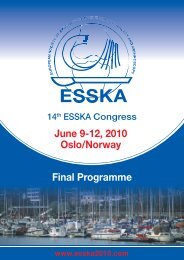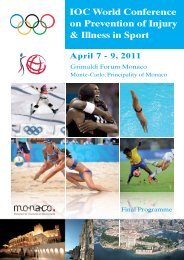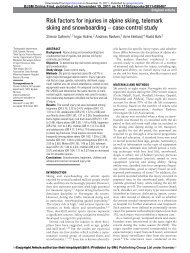Lian_2006_AJSM_Pronociceptive and antinociceptive ...
Lian_2006_AJSM_Pronociceptive and antinociceptive ...
Lian_2006_AJSM_Pronociceptive and antinociceptive ...
Create successful ePaper yourself
Turn your PDF publications into a flip-book with our unique Google optimized e-Paper software.
American Journal of Sports<br />
Medicine<br />
http://ajs.sagepub.com<br />
<strong>Pronociceptive</strong> <strong>and</strong> Antinociceptive Neuromediators in Patellar Tendinopathy<br />
Øystein <strong>Lian</strong>, Johan Dahl, Paul W. Ackermann, Frede Frihagen, Lars Engebretsen <strong>and</strong> Roald Bahr<br />
Am. J. Sports Med. <strong>2006</strong>; 34; 1801 originally published online Jun 30, <strong>2006</strong>;<br />
DOI: 10.1177/0363546506289169<br />
The online version of this article can be found at:<br />
http://ajs.sagepub.com/cgi/content/abstract/34/11/1801<br />
Published by:<br />
http://www.sagepublications.com<br />
On behalf of:<br />
American Orthopaedic Society for Sports Medicine<br />
Additional services <strong>and</strong> information for American Journal of Sports Medicine can be found at:<br />
Email Alerts: http://ajs.sagepub.com/cgi/alerts<br />
Subscriptions: http://ajs.sagepub.com/subscriptions<br />
Reprints: http://www.sagepub.com/journalsReprints.nav<br />
Permissions: http://www.sagepub.com/journalsPermissions.nav<br />
Citations (this article cites 29 articles hosted on the<br />
SAGE Journals Online <strong>and</strong> HighWire Press platforms):<br />
http://ajs.sagepub.com/cgi/content/abstract/34/11/1801#BIBL<br />
Downloaded from http://ajs.sagepub.com at SWETS WISE ONLINE CONTENT on March 27, 2007<br />
© <strong>2006</strong> American Orthopaedic Society for Sports Medicine. All rights reserved. Not for commercial use or unauthorized distribution.
<strong>Pronociceptive</strong> <strong>and</strong> Antinociceptive<br />
Neuromediators in Patellar Tendinopathy<br />
Øystein <strong>Lian</strong>,* † MD, Johan Dahl, ‡ MD, Paul W. Ackermann, ‡ MD, PhD, Frede Frihagen, § MD,<br />
Lars Engebretsen,* § MD, PhD, <strong>and</strong> Roald Bahr,* ll MD, PhD<br />
From the *Oslo Sports Trauma Research Center, Department of Sports Medicine, Norwegian<br />
School of Sport Sciences, Oslo, Norway, † Kristiansund Hospital, Kristiansund, Norway,<br />
‡ Orthopedic Laboratory, Department of Molecular Medicine <strong>and</strong> Surgery, Karolinska Institutet,<br />
Stockholm, Sweden, <strong>and</strong> § Orthopaedic Center, Ullevål University Hospital, Oslo, Norway<br />
Background: The occurrence of nerve ingrowth <strong>and</strong> its relation to chronic tendon pain (tendinopathy) are still largely unknown. In<br />
healthy tendons, the innervation is confined to the paratenon, whereas the tendon proper is devoid of nerve fibers. In this study on<br />
the pathogenesis of tendinopathy, the authors examined sensory <strong>and</strong> sympathetic nerve fiber occurrence in the patellar tendon.<br />
Hypothesis: Nerve ingrowth <strong>and</strong> altered expression of sensory <strong>and</strong> sympathetic neuromediators play a major role in the pathophysiology<br />
of pain in patellar tendinopathy.<br />
Study Design: Case control study; Level of evidence, 3.<br />
Methods: Biopsies from the patellar tendon in patients with patellar tendinopathy (n = 10) were compared with biopsies from a<br />
control group (n = 10) without any previous or current knee symptoms compatible with patellar tendinopathy. The biopsies were<br />
stained immunohistochemically for sensory <strong>and</strong> autonomic nerve markers. The biopsies from the 2 groups were compared using<br />
subjective <strong>and</strong> semiquantitative methods.<br />
Results: Chronic painful patellar tendons exhibited increased occurrence of sprouting nonvascular sensory, substance<br />
P–positive nerve fibers <strong>and</strong> a decreased occurrence of vascular sympathetic nerve fibers, positive to tyroxin hydroxylase, a<br />
marker for noradrenaline.<br />
Conclusion: The altered sensory-sympathetic innervation suggests a role in the pathophysiology of tendinopathy. Ingrowth of<br />
sprouting substance P fibers presumably reflects a nociceptive <strong>and</strong> maybe a proliferative role, possibly as reactions to repeated<br />
microtraumata, whereas the decreased occurrence of tyroxin hydroxylase may represent a reduced <strong>antinociceptive</strong> role. These<br />
findings could be used to develop targeted pharmacotherapy for the specific treatment of tendinopathy.<br />
Keywords: tendon; pain; jumper’s knee; substance P (SP); noradrenaline<br />
Tendinopathy is a major cause of sick leave, 9 as well as<br />
morbidity related to athletic performance. 21 However, the<br />
basic pathogenesis of pain <strong>and</strong> degeneration in chronic<br />
tendon disease is generally poorly understood, which limits<br />
our ability to develop specific therapeutic interventions.<br />
In the absence of inflammation, the chemical <strong>and</strong> morphologic<br />
substrate for the experienced pain is also mostly<br />
unknown. However, neurogenic inflammation was recently<br />
ll Address correspondence to Roald Bahr, MD, PhD, Oslo Sports<br />
Trauma Research Center, Norwegian School of Sport Sciences, PO Box<br />
4014, Ullevål Stadion, 0806 Oslo, Norway (e-mail: roald@nih.no).<br />
No potential conflict of interest declared.<br />
The American Journal of Sports Medicine, Vol. 34, No. 11<br />
DOI: 10.1177/0363546506289169<br />
© <strong>2006</strong> American Orthopaedic Society for Sports Medicine<br />
implicated in the origin of achillodynia, 13 suggesting new<br />
therapeutic targets to mitigate symptoms.<br />
Patellar tendinopathy is believed to be a tendon overload<br />
injury caused by a combination of internal <strong>and</strong> external<br />
risk factors. 29 Studies using Doppler flow technique 6,7,28 <strong>and</strong><br />
histologic evaluations 25,26 have demonstrated increased<br />
blood vessel density in patients with degenerative tendon<br />
disease. Blood vessels cannot explain the pain suffered by<br />
these patients, <strong>and</strong> thus other factors related to pain<br />
pathophysiology, among them neuromediators, have been<br />
suggested 3,5,19,33 but are yet unidentified in patellar<br />
tendinopathy.<br />
Recent observations have established that normal<br />
innervation of the tendon envelope (paratenon <strong>and</strong> surrounding<br />
loose connective tissue) consists of sensory <strong>and</strong><br />
autonomic nerve fibers, 2,3,5 which are suggested to play an<br />
1801<br />
Downloaded from http://ajs.sagepub.com at SWETS WISE ONLINE CONTENT on March 27, 2007<br />
© <strong>2006</strong> American Orthopaedic Society for Sports Medicine. All rights reserved. Not for commercial use or unauthorized distribution.
1802 <strong>Lian</strong> et al The American Journal of Sports Medicine<br />
important role in the regulation of pain, inflammation, <strong>and</strong><br />
tissue repair. 12,13,24,26 However, the healthy tendon proper<br />
is practically devoid of nerve fibers. 2,3,5 From other pain<br />
conditions, for example, low back pain, a relationship<br />
between sensory nerve ingrowth with expression of substance<br />
P (SP) in the disc <strong>and</strong> pathogenesis of pain has been<br />
shown. 16 Recently, SP was also demonstrated in Achilles<br />
tendinopathy. 5,10,33 In rheumatoid arthritis, a connection<br />
has been demonstrated between decreased sympathetic<br />
input (ie, low levels of noradrenaline) <strong>and</strong> decreased antiinflammatory<br />
capability. 34<br />
However, in tendinopathy, the relative ratio of sensory<br />
<strong>and</strong> autonomic nerve fibers <strong>and</strong> their clinical relationship to<br />
pain have not been studied. Thus, in this study, we compared<br />
the occurrence of sensory <strong>and</strong> sympathetic nerve fibers<br />
between chronic painful patellar tendons <strong>and</strong> controls.<br />
METHODS<br />
Patient Groups<br />
The patient group included athletes from different sports<br />
who were included in a prospective r<strong>and</strong>omized trial comparing<br />
surgery with eccentric training. 8 The following<br />
diagnostic criteria were used for patellar tendinopathy:<br />
history of exercise-related pain in the proximal patellar<br />
tendon or the patellar insertion <strong>and</strong> distinct tenderness<br />
to palpation corresponding to the painful area. 11 To be<br />
included in the study, the patients had to have a clinical<br />
diagnosis of jumper’s knee grade IIIB; that is, the patient<br />
had pain during <strong>and</strong> after activity <strong>and</strong> was unable to participate<br />
in sports at the same level as before pain. 22,32 In<br />
addition, the patient had to have thickening <strong>and</strong> signal<br />
changes on the MRI corresponding to the painful area to<br />
ensure that the biopsies were taken from the tendinopathic<br />
area. Patients had to have symptoms for a minimum<br />
of 3 months <strong>and</strong> be willing to undergo surgery.<br />
Subjects were excluded if they had a history of knee or<br />
patellar tendon surgery, inflammatory joint conditions, or<br />
degenerative conditions. Both knees were included if the<br />
patient had bilateral problems.<br />
Each patient went through a st<strong>and</strong>ardized interview,<br />
<strong>and</strong> the information requested from each athlete included<br />
age, height, weight, <strong>and</strong> number of years participating in<br />
organized athletic training. Patients were asked to report<br />
the number of training hours per week during the competition<br />
season (sport-specific training, weight training, jump<br />
training, <strong>and</strong> other types of training). To assess the severity<br />
of the condition, the athletes with current patellar<br />
tendinopathy also self-recorded their symptoms <strong>and</strong> level<br />
of sports function using the Victorian Institute of Sport<br />
Assessment (VISA) questionnaire. 36 This brief questionnaire<br />
assesses symptoms, function, <strong>and</strong> the ability<br />
to play sport. 36 The maximal VISA score for an asymptomatic,<br />
fully performing individual is 100 points, <strong>and</strong> the<br />
theoretical minimum is 0. 36 The VISA questionnaire has<br />
shown excellent short-term test-retest reliability <strong>and</strong> has<br />
been shown to be a valid measure of symptoms in patients<br />
with patellar tendinopathy. 36<br />
The control group was selected from patients with tibia<br />
fractures from low-energy trauma treated with marrow<br />
nailing. These patients could have no current or previous<br />
knee symptoms compatible with patellar tendinopathy.<br />
Subjects in both groups had to be at least 18 years old (to<br />
ensure that the epiphyses were closed) <strong>and</strong> able to underst<strong>and</strong><br />
oral <strong>and</strong> written Norwegian.<br />
Exclusion criteria in both groups were previous surgical<br />
treatment in or around the same knee, corticosteroid injections<br />
in or around the same knee, serious traumatic injury<br />
affecting the same knee, any rheumatic disease, <strong>and</strong> degenerative<br />
knee disorders. The study was approved by the<br />
regional committee for research ethics, participation was<br />
voluntary, <strong>and</strong> consent was obtained.<br />
Surgical Technique<br />
The surgical exposure was identical in the 2 groups, with a<br />
5-cm longitudinal midline or lateral parapatellar incision,<br />
splitting of the paratenon, <strong>and</strong> exposure of the patellar<br />
ligament. The paratenon was split longitudinally, any<br />
pathologic paratenon tissue was removed, <strong>and</strong> the tendon<br />
was fully exposed. In both groups, the biopsies were taken<br />
from the proximal bone-ligament junction. The tendon tissue<br />
was excised using a full-thickness wedge-shaped incision,<br />
wide from the patellar pole <strong>and</strong> narrowing distally. In<br />
the patient group, all abnormal tissue was removed. If<br />
clearly abnormal tissue was not seen macroscopically, the<br />
excision was based on the MRI signal changes. Typically,<br />
a wedge with a proximal base 1 cm wide <strong>and</strong> extending to<br />
an apex 20 to 30 mm distal from the patellar pole was<br />
removed. In the control group, the biopsies were taken<br />
with a width of at least 5 mm <strong>and</strong> a length of at least<br />
20 mm from the middle portion of the ligament starting at<br />
the bone-ligament junction.<br />
Biopsy Procedure<br />
The biopsy h<strong>and</strong>ling was identical in the 2 groups.<br />
Immediately after the surgical procedure, the biopsies<br />
were transferred to Zamboni solvent. 38 The biopsies were<br />
stored in this solution for 4 to 24 hours <strong>and</strong> then washed<br />
in 0.1-M phosphate-buffered saline (PBS), pH 7.2, with<br />
15% sucrose (weight/volume) <strong>and</strong> 0.1% natriumazide. This<br />
washing was done until the yellow color from the Zamboni<br />
solution could no longer be seen in the PBS solvent. The<br />
biopsies were then stored in PBS at 4°C for a minimum of<br />
48 hours.<br />
The samples were sectioned at 154µm on a Leitz cryostat,<br />
<strong>and</strong> frozen sections were mounted directly on Super-<br />
Frost/Plus glass slides, 3 sections per slide, <strong>and</strong> stained<br />
using the avidin-biotin or the hematoxylin <strong>and</strong> eosin systems,<br />
for immunohistochemistry <strong>and</strong> light microscopy,<br />
respectively.<br />
Morphologic Study. The hematoxylin- <strong>and</strong> eosin-stained<br />
slides were subjectively assessed by a single blinded<br />
observer <strong>and</strong> graded according to the Bonar scale 15 with<br />
regard to tenocyte morphologic characteristics <strong>and</strong> vascularity<br />
(Table 1).<br />
Downloaded from http://ajs.sagepub.com at SWETS WISE ONLINE CONTENT on March 27, 2007<br />
© <strong>2006</strong> American Orthopaedic Society for Sports Medicine. All rights reserved. Not for commercial use or unauthorized distribution.
Vol. 34, No. 11, <strong>2006</strong> Neuromediators in Patellar Tendinopathy 1803<br />
TABLE 1<br />
Modified Bonar Scale a<br />
Grade<br />
0 1 2 3<br />
Tenocytes Inconspicuous, elongated, Increased roundness; Increased roundness Nucleus is round <strong>and</strong> large,<br />
spindle-shaped nuclei with nuclei becomes ovoid <strong>and</strong> size; the nucleus with abundant cytoplasm<br />
no obvious cytoplasm at to round in shape is round <strong>and</strong> slightly <strong>and</strong> lacuna formation<br />
light microscopy without conspicuous enlarged; a small amount (chondroid change)<br />
cytoplasm<br />
of cytoplasm is visible<br />
Blood vessels Inconspicuous blood Occasional cluster 1-2 clusters per 10 More than 2 clusters<br />
vessels coursing in of capillaries; less high-power fields per 10 high-power fields<br />
between bundles than 1 per 10<br />
high-power fields<br />
a See Cook et al. 15 The scale is a semiquantitative tendon score based on tenocyte <strong>and</strong> blood vessel morphologic characteristics (grading of<br />
ground substance <strong>and</strong> collagen is not included in this reproduction).<br />
Immunohistochemistry. The slides were rinsed for 10<br />
minutes in PBS. Incubation with 10% normal goat serum<br />
in PBS for 30 minutes blocked nonspecific binding.<br />
Subsequently, the sections were incubated overnight in a<br />
humid atmosphere at +8°C with primary antisera for protein<br />
gene product 9.5 (PGP, 1:10 000, UltraClone, Wellow,<br />
United Kingdom), SP (1:10 000, Peninsula Laboratories,<br />
San Carlos, Calif), <strong>and</strong> tyrosine hydroxylase (TH, 1:5000,<br />
Peninsula Laboratories), a rate-limiting enzyme reflecting<br />
the occurrence of noradrenaline. The PGP is the carboxylterminal<br />
hydrolase to the ubiquitin protein, which is an<br />
important protein component in the axonal neurolemma<br />
<strong>and</strong> is used as a general nerve marker, which makes it possible<br />
to identify the total number of nerve fibers. 17,24,37<br />
After incubation with the primary antisera, the sections<br />
were rinsed in PBS (3-5 minutes) <strong>and</strong> then incubated with<br />
biotinylated goat antirabbit antibodies (1:250, Vector<br />
Laboratories, Burlingame, Calif) for 40 minutes at room<br />
temperature. Finally, the sections were incubated for 40<br />
minutes with Cy3-conjugated avidin (1:5000, Amersham<br />
International, Stafford, United Kingdom). Control staining<br />
was performed by omitting the primary antiserum. A<br />
Nikon epifluorescence microscope (Eclipse E800, Nikon,<br />
Yokohama, Japan) was used for the analyses. The slides<br />
were examined by 2 independent observers, who were<br />
blinded with regard to the group to which the slides<br />
belonged. The occurrence <strong>and</strong> neuromorphology of PGP, SP,<br />
<strong>and</strong> TH were subjectively assessed, <strong>and</strong> pictures were<br />
taken for subsequent semiquantitative analyses.<br />
Semiquantitative Analysis. After the subjective assessment,<br />
the following steps identified in an earlier study 1 were<br />
applied to optimize the semiquantitative analysis: The<br />
patellar tendons were longitudinally sectioned, <strong>and</strong> the sections<br />
were numbered consecutively from the dorsal to the<br />
ventral aspect. Three sections from different levels (ie, ventral,<br />
middle, <strong>and</strong> dorsal parts of the tendon) were chosen to<br />
represent the full thickness of the tendon. Staining was performed<br />
simultaneously for all sections to be compared. For<br />
microscopic analysis, a video camera system (DXM 1200,<br />
Nikon) was attached to the epifluorescence microscope <strong>and</strong><br />
connected to a computer. From each section, 3 images from<br />
the microscopic fields (× 20 objective) exhibiting the<br />
strongest immunofluorescence were stored in the computer.<br />
Thereafter, the images were analyzed using Easy Analysis<br />
software (Technooptik, Skarholmen, Sweden). The software<br />
denotes <strong>and</strong> considers all positively stained nerve fibers<br />
beyond a defined threshold of fluorescent intensity. The<br />
results were expressed as the fractional area occupied by<br />
positive fibers in relation to the total area. The fluorescent/total<br />
area was determined in 9 images in each biopsy of<br />
the patient <strong>and</strong> control groups, respectively. In the microscopic<br />
analysis, the mean interobserver coefficient of variation<br />
was 9.8% <strong>and</strong> the intraobserver variation 9.6%. For<br />
statistical analysis, the mean fluorescent/total area was calculated<br />
for each of the 10 biopsies from both the patient <strong>and</strong><br />
the control groups.<br />
Data Analysis<br />
For continuous variables, the results are given as means<br />
with range, unless otherwise noted. Comparisons between<br />
groups were done using unpaired t tests, as noted in<br />
the “Results” section. An α level of .05 was considered<br />
significant.<br />
A sample size analysis based on the results of earlier<br />
immunohistochemical semiquantification studies, using<br />
an estimated average of 0.65 <strong>and</strong> 1 <strong>and</strong> an SD of 0.3 <strong>and</strong><br />
0.4 in the 2 groups, respectively, as well as an α level of .05<br />
<strong>and</strong> a β level of .30, resulted in a sample size of 10.<br />
RESULTS<br />
The mean age was 30 years (range, 24-34 years; n = 10) in<br />
the patient group <strong>and</strong> 29 years (range, 19-43 years; n = 10)<br />
in the control group. In the patient group, the mean number<br />
of years participating in organized training was 17<br />
(range, 10-28 years; n = 10), <strong>and</strong> the mean number of total<br />
training hours per week was 14 (range, 6-24 hours; n = 10).<br />
The mean VISA score was 42 (range, 15-65; n = 10), <strong>and</strong> the<br />
Downloaded from http://ajs.sagepub.com at SWETS WISE ONLINE CONTENT on March 27, 2007<br />
© <strong>2006</strong> American Orthopaedic Society for Sports Medicine. All rights reserved. Not for commercial use or unauthorized distribution.
1804 <strong>Lian</strong> et al The American Journal of Sports Medicine<br />
Figure 1. Hematoxylin <strong>and</strong> eosin micrographs of longitudinal sections through the patellar tendon of healthy control (A) <strong>and</strong><br />
painful tendinopathy (B). Arrows denote tenocytes. The healthy tendon is homogeneous, with organized parallel collagen structure<br />
<strong>and</strong> thin, elongated tenocytes (A). The tendinopathy, on the other h<strong>and</strong>, is marked by collagen disorganization, increased<br />
cell count, activated tenocytes, <strong>and</strong> vascular ingrowth (V) in the tendon proper (B). Bar, 50 µm.<br />
mean duration of symptoms was 36 months (range, 5-120<br />
months; n = 10).<br />
Microscopy<br />
The morphologic appearance of the painful tendons in<br />
the tendon proper differed significantly compared with the<br />
appearance of the controls. The proper tendinous tissue<br />
exhibited signs of tendinosis (collagen degeneration, fiber<br />
disorientation, hypercellularity, angiogenesis, <strong>and</strong> absence<br />
of inflammatory cells) in all but 1 of the patients, whereas<br />
only a few of the controls exhibited early signs of tendinosis<br />
(Figure 1).<br />
Semiquantitative assessment of tenocyte morphologic<br />
characteristics <strong>and</strong> of angiogenesis according to the Bonar<br />
scale, as signs of early <strong>and</strong> later stages of tendinosis, respectively,<br />
was performed. 15 Tenocyte changes occurred in all but<br />
1 of the painful tendons, whereas only 3 of 10 controls exhibited<br />
these changes (P = .006). Angiogenesis, considered to be<br />
the last histologic sign of tendinopathy, 15 was found in 4 of<br />
10 painful tendons but in none of the controls (P = .038).<br />
Immunohistochemistry<br />
Overall, the subjective immunohistochemical assessment<br />
confirmed the morphologic appearance. However, it also<br />
provided more detailed information about sensory (SP)<br />
<strong>and</strong> sympathetic (TH) nerve fiber occurrence in the patellar<br />
tendon. Thus, the majority (7/10) of the painful tendons<br />
exhibited an increased number of nerve fibers positive to<br />
SP <strong>and</strong> notably decreased levels of TH.<br />
Sensory Nerves<br />
Closer subjective analysis showed that the increased number<br />
of SP-positive fibers in the painful tendons occurred<br />
mainly as thin, varicose, sprouting nonvascular nerve<br />
terminals within the tendon proper (Figure 2B). Notably,<br />
these SP-positive nerves in the painful tendons were<br />
found over a larger area, more spread out within the tendon<br />
than in the controls. The SP-positive nerve fibers, seen<br />
as free nerve endings interspersed between the proper collagen<br />
fibers, often accompany the loose connective<br />
tissue ingrowth within the tendon proper of the painful<br />
tendons. Contrary to what one might have expected, no<br />
differences were noted between the groups regarding the<br />
small subpopulation of vascular SP-positive fibers. In both<br />
groups, SP was regularly seen in larger nerve bundles<br />
(Figure 2A).<br />
Sympathetic Nerves<br />
Subjective analysis demonstrated a great difference not<br />
only in the occurrence of TH-expressing nerve fibers<br />
between patients <strong>and</strong> controls but also in their morphologic<br />
distribution. In both groups, TH-positive nerves were<br />
present as free nerve endings throughout the tendon<br />
proper, but unlike the sensory nerves, the majority of the<br />
TH-positive nerves were distinctively related to the blood<br />
vessels (Figure 3A). In the patients, there was a distinct<br />
decrease in the occurrence of TH-positive nerves. Some THpositive<br />
free nerve endings were still seen, but the vesselrelated<br />
TH nerves in the patients were significantly<br />
diminished (Figure 3B).<br />
General Nerve Occurrence<br />
The neuronal localization of SP <strong>and</strong> TH staining was confirmed<br />
by positive immunoreactivity for PGP, a general<br />
nerve marker. The subjective analysis of PGP showed a<br />
distinctively higher nerve fiber occurrence in the chronic<br />
pain group compared with the controls. Nerves existed as<br />
Downloaded from http://ajs.sagepub.com at SWETS WISE ONLINE CONTENT on March 27, 2007<br />
© <strong>2006</strong> American Orthopaedic Society for Sports Medicine. All rights reserved. Not for commercial use or unauthorized distribution.
Vol. 34, No. 11, <strong>2006</strong> Neuromediators in Patellar Tendinopathy 1805<br />
Figure 2. Immunofluorescence micrographs of longitudinal sections through the patellar tendon of healthy control (A) <strong>and</strong> painful<br />
tendinopathy (B) after incubation with antisera to substance P (SP). In the control tendon, SP-positive nerve fibers are mainly<br />
present as vascular nerve fibers <strong>and</strong> as large bundles (arrow) in the loose connective tissue (lct; A). In painful tendinopathy,<br />
increased spread <strong>and</strong> sprouting of SP-positive nerve fibers (arrows) are seen (B). These sprouting nerves even invade the tendon<br />
proper (t). Bar, 50 µm.<br />
Figure 3. Immunofluorescence micrographs of longitudinal sections through the patellar tendon of healthy control (A) <strong>and</strong> painful<br />
tendinopathy (B) stained for tyrosine hydroxylase (TH, a marker for noradrenaline). Arrows denote nerve fibers. In the healthy tendon,<br />
a strong relation is seen between blood vessels <strong>and</strong> TH-positive nerves (A). In painful tendinopathy, a decreased number of<br />
TH-positive nerves, which are blood vessel related, are seen. V, blood vessel. Bar, 50 µm.<br />
both vascular <strong>and</strong> nonvascular free nerve endings <strong>and</strong> in<br />
larger bundles.<br />
Semiquantitative Immunohistochemistry<br />
Computerized image analysis of SP, TH, <strong>and</strong> PGP expression<br />
showed similar differences in occurrence as assessed<br />
subjectively, although not all results were significant. The<br />
occurrence of SP was 22% (P = .567) <strong>and</strong> that of PGP 54%<br />
(P = .098) higher in the chronic painful tendons than in<br />
the controls. The occurrence of TH in the chronic painful<br />
tendons was 53% lower than in the controls (P = .018)<br />
(Figure 4).<br />
DISCUSSION<br />
This study demonstrates that the composition of nerve<br />
fibers expressing sensory (SP) <strong>and</strong> sympathetic neuromediators<br />
(TH) appears to differ between patients with painful<br />
Downloaded from http://ajs.sagepub.com at SWETS WISE ONLINE CONTENT on March 27, 2007<br />
© <strong>2006</strong> American Orthopaedic Society for Sports Medicine. All rights reserved. Not for commercial use or unauthorized distribution.
1806 <strong>Lian</strong> et al The American Journal of Sports Medicine<br />
A<br />
Area fraction (%)<br />
B<br />
Area fraction (%)<br />
C<br />
Area fraction (%)<br />
1<br />
0.8<br />
0.6<br />
0.4<br />
0.2<br />
0<br />
0.8<br />
0.6<br />
0.4<br />
0.2<br />
0<br />
0.8<br />
0.6<br />
0.4<br />
0.2<br />
0<br />
Pain<br />
Pain<br />
Pain<br />
Substance P<br />
Control<br />
patellar tendinopathy <strong>and</strong> controls. Most notably, a painful<br />
tendon is characterized by an increased number of SPpositive<br />
nonvascular nerve endings <strong>and</strong> a vascularly related<br />
decrease in TH, a marker of noradrenaline.<br />
Tendinopathy is defined as a chronic <strong>and</strong> painful tendon<br />
disorder. The patients of this study had a mean symptom<br />
duration of 3 years <strong>and</strong> a VISA score of 42, which indicates<br />
a high level of pain <strong>and</strong> significant disability. 36 All patients<br />
exhibited transformed tenocytes, in contrast to only 3 of 10<br />
controls. Angiogenesis, considered to be an advanced histologic<br />
sign of tendinopathy, 15 was found in 4 of 10 painful<br />
tendons but in none of the controls. This means that the<br />
histopathologic findings in this study can be interpreted as<br />
characteristic of a patient group with chronic <strong>and</strong> severe<br />
complaints of patellar tendinopathy. We do not know the<br />
activity level in the control group, but because the<br />
described histopathologic changes are assumed to be typical<br />
of a chronic overload injury, we do not expect to find<br />
ns<br />
TH<br />
*<br />
PGP<br />
ns<br />
Control<br />
Control<br />
Figure 4. Mean area fraction occupied by nerve fibers (%)<br />
immunoreactive to SP (A), TH (B), <strong>and</strong> PGP (C) in painful patellar<br />
tendons as compared with controls (± st<strong>and</strong>ard error of<br />
the mean). *P < .05. Not significant (ns), P > .05. SP, substance<br />
P; TH, tyrosine hydroxylase; PGP, protein gene product.<br />
these changes in asymptomatic tendons. However, from a<br />
methodological point of view, this possibility cannot be<br />
completely excluded.<br />
The altered peripheral sensory-sympathetic innervation<br />
in patients suggests a role in the pathophysiology of<br />
tendinopathy. 31 Increased ingrowth of sensory nerves into<br />
the painful tendon proper, seen as sprouting free nerve<br />
endings, may explain the pain by reflecting intensified<br />
nociceptive transmission as a response to, for example,<br />
repetitive mechanical stimuli. The sympathetic nerves<br />
that are believed to act <strong>antinociceptive</strong>ly exhibited a<br />
reduced occurrence in the patients studied, thus supporting<br />
the notion that the observed changes in peripheral<br />
innervation are involved in the regulation of tendon pain.<br />
The peripheral nervous system is known to react to outer<br />
<strong>and</strong> inner stress. It has been demonstrated that sensory<br />
nerve ingrowth <strong>and</strong> decreased sympathetic innervation<br />
occur as a response to tendon injury, 4 indicating that<br />
repeated microtrauma might be an initiator of the neuronal<br />
response. Moreover, the same study established that nociception<br />
during early healing is related to increased sensory<br />
<strong>and</strong> decreased autonomic neuromediator occurrence.<br />
In this study, we focused on SP <strong>and</strong> not on calcitonin<br />
gene-related peptide because the research on SP is further<br />
advanced compared with that on calcitonin gene-related<br />
peptide. Thus, the relationship between SP <strong>and</strong> chronic<br />
pain is more established, also with regard to tendinopathy<br />
<strong>and</strong> tendon healing. 14,23,33<br />
The increased occurrence of SP in tendinopathy may<br />
reflect a multitude of actions. Substance P has been found to<br />
participate in inflammatory actions like vasodilation, plasma<br />
extravasation, <strong>and</strong> release of cytokines, in addition to its<br />
role in nociception, where SP has been reported to directly<br />
stimulate nociceptor endings in an autocrine/paracrine<br />
manner. 35 Similar actions may be presumed to occur in<br />
tendinopathy because it has been demonstrated that SP<br />
receptors are present. 23 The existence of SP within the tendon<br />
proper of the painful patellar tendons was in fact<br />
observed mainly in free nerve endings, indicating that the<br />
main function of SP in tendinopathy is nociceptive rather<br />
than vasoactive.<br />
The reduction in TH, that is, vasoregulatory noradrenaline,<br />
suggests a suppressed <strong>antinociceptive</strong> function. A<br />
recent report has demonstrated that noradrenaline release<br />
leads to secretion of opioids from leukocytes. 30 Notably, a<br />
similar pattern of decreased vascular TH <strong>and</strong> increased<br />
free SP-positive nerve fibers is seen in patients with<br />
painful rheumatoid arthritis. 34<br />
In addition, the up-regulation of SP seen within the pathogenic<br />
tendon proper might reflect a trophic role. Substance<br />
P has in fact been shown to stimulate proliferation of fibroblasts<br />
14 <strong>and</strong> endothelial cells, 27 as well as the production of<br />
transforming growth factor β in fibroblasts. 20 It is therefore<br />
tempting to speculate that SP contributes to the morphologic<br />
changes observed in tendinopathic patients, that is,<br />
tenocyte transformation, hypercellularity, <strong>and</strong> presumably<br />
neovascularization. Whether neuronal <strong>and</strong> cellular alterations<br />
in tendinopathy can be correlated requires further<br />
studies. It remains to be seen if the pain level is related to<br />
the ratio of SP to TH or to the degree of neovascularization.<br />
Downloaded from http://ajs.sagepub.com at SWETS WISE ONLINE CONTENT on March 27, 2007<br />
© <strong>2006</strong> American Orthopaedic Society for Sports Medicine. All rights reserved. Not for commercial use or unauthorized distribution.
Vol. 34, No. 11, <strong>2006</strong> Neuromediators in Patellar Tendinopathy 1807<br />
The protracted presence of SP in tendinopathy is pathologic,<br />
in contrast to its trophic role in normal tendon healing. For<br />
progression of normal tendon healing, it has been shown<br />
that a strict temporal orchestration of neuromediator<br />
occurrence is essential. Thus, an initial up-regulation in SP<br />
at the healing site during the inflammatory <strong>and</strong> regenerative<br />
phases is followed by disappearance of SP <strong>and</strong> emergence<br />
of TH, representing a progress of healing. 4 However,<br />
in tendinopathic patients, the normal healing process<br />
appears to be at a st<strong>and</strong>still, characterized by high levels<br />
of SP <strong>and</strong> low levels of TH. Considering the similarities to<br />
rheumatoid arthritis, 34 increased SP expression in tendinopathy<br />
might even be part of a neuroinflammatory process.<br />
The classic vessel-related proinflammatory actions of SP<br />
may occur in the tendon envelope, that is, the paratenon<br />
<strong>and</strong> loose connective tissue, as demonstrated by an experimental<br />
study, whereas in the tendon proper, no classic<br />
inflammation was seen. 13 These observations are similar<br />
to the mostly free SP nerve endings seen in the current<br />
study. The prolonged release of SP from free nerves in the<br />
painful tendons may, as a neuroinflammatory process, suppress<br />
the synthesis of growth factors <strong>and</strong> increase the<br />
levels of stromelysin (endopeptidase, metalloproteinase) in<br />
the tendon. 18 Hence, the demonstrated up-regulation of<br />
SP might lead to subsequent matrix destruction in the<br />
pathogenic tendon proper.<br />
In this study, the variation between biopsies was high,<br />
<strong>and</strong> the semiquantitative analysis confirmed only 1 of the<br />
3 subjective analyses of the neuromediators in question.<br />
However, the trends all pointed in the same direction. The<br />
semiquantitative method takes only the fields with highest<br />
density of immunofluorescence into account, thus overlooking<br />
histologic differences, such as extensive nerve<br />
sprouting. The semiquantitative analysis should therefore<br />
only be regarded as a complement to the subjective analysis.<br />
Although the up-regulated SP occurrence was demonstrated<br />
exclusively by subjective analysis, the observations<br />
were corroborated by a recent report on Achilles tendinosis<br />
demonstrating increased SP levels in tendinopathy. 33<br />
In conclusion, this study demonstrates a differentiation<br />
in the sensory <strong>and</strong> sympathetic neuromediator pattern in<br />
patients with painful tendinopathy. The dominance of nonvascular<br />
SP nerve endings as well as the decrease of the<br />
<strong>antinociceptive</strong> modulator noradrenaline suggest a pathophysiologic<br />
up-regulation of pain. Both these neuropeptides,<br />
known to be essential for normal healing, exhibit a<br />
disturbed balance that may contribute to the degenerative<br />
<strong>and</strong> painful processes of tendinopathy. The underst<strong>and</strong>ing<br />
of the neuronal pathomechanisms may suggest new therapeutic<br />
targets to mitigate the symptoms in patients with<br />
painful tendon disorders.<br />
ACKNOWLEDGMENT<br />
The Oslo Sports Trauma Research Center has been established<br />
at the Norwegian School of Sport Sciences through generous<br />
grants from the Norwegian Eastern Health Corporate,<br />
the Royal Norwegian Ministry of Culture, the Norwegian<br />
Olympic Committee & Confederation of Sport, Norsk Tipping<br />
AS, <strong>and</strong> Pfizer AS. The authors thank Sverre Løken, MD, for<br />
help with surgical procedures <strong>and</strong> taking biopsies.<br />
REFERENCES<br />
1. Ackermann PW, Ahmed M, Kreicbergs A. Early nerve regeneration<br />
after Achilles tendon rupture: a prerequisite for healing? A study in the<br />
rat. J Orthop Res. 2002;20:849-856.<br />
2. Ackermann PW, Finn A, Ahmed M. Sensory neuropeptidergic pattern<br />
in tendon, ligament <strong>and</strong> joint capsule: a study in the rat. Neuroreport.<br />
1999;13;2055-2060.<br />
3. Ackermann PW, Li J, Finn A, Ahmed M, Kreicbergs A. Autonomic<br />
innervation of tendons, ligaments <strong>and</strong> joint capsules: a morphologic<br />
<strong>and</strong> quantitative study in the rat. J Orthop Res. 2001;19:372-378.<br />
4. Ackermann PW, Li J, Lundeberg T, Kreicbergs A. Neuronal plasticity<br />
in relation to nociception <strong>and</strong> healing of rat Achilles tendon. J Orthop<br />
Res. 2003;21:432-441.<br />
5. Ackermann PW, Renström P. Sensory neuropeptides in Achilles tendinosis:<br />
transactions of the Third Biennial Congress of the International<br />
Society of Arthroscopy, Knee Surgery <strong>and</strong> Orthopaedic Sports<br />
Medicine. Arthroscopy. 2001;17(suppl):516.<br />
6. Alfredsson H, Lorentzon M, Bäckman S, Bäckman A, Lerner U. cDNAarrays<br />
<strong>and</strong> real-time quantitative PCR techniques in the investigation of<br />
chronic Achilles tendinosis. J Orthop Res. 2003;21:970-975.<br />
7. Astrom M, Westlin N. Blood flow in the human Achilles tendon<br />
assessed by laser Doppler flowmetry. J Orthop Res. 1994;12:246-252.<br />
8. Bahr R, Fossan B, Løken S, Engebretsen L. Surgical treatment versus<br />
eccentric training for patellar tendinopathy (jumper’s knee): a r<strong>and</strong>omized<br />
controlled trial. J Bone Joint Surg Am. In press.<br />
9. Barnard P. Musculoskeletal Disorders <strong>and</strong> Workplace Factors: A<br />
Critical Review of Epidemiologic Evidence For Work-Related<br />
Musculoskeletal Disorders Of The Neck, Upper Extremity, And Low<br />
Back. Cincinnati, Ohio: US Department of Health <strong>and</strong> Human<br />
Services, National Institute of Occupational Safety <strong>and</strong> Health; 1997.<br />
10. Bjur D, Alfredson H, Forsgren S. The innervation pattern of the human<br />
Achilles tendon: studies of the normal <strong>and</strong> tendinosis tendon with<br />
markers for general <strong>and</strong> sensory innervation. Cell Tissue Res. 2005;<br />
320:201-206.<br />
11. Blazina ME, Kerlan RK, Jobe FW, Carter VS, Carlson GJ. Jumper’s<br />
knee. Orthop Clin North Am. 1973;4:665-673.<br />
12. Brain SD. Sensory neuropeptides: their role in inflammation <strong>and</strong><br />
wound healing. Immunopharmacology. 1997;37:133-150.<br />
13. Bring DK, Heidgren ML, Kreicbergs A, Ackermann PW. Increase in<br />
sensory neuropeptides surrounding the Achilles tendon in rats with<br />
adjuvant arthritis. J Orthop Res. 2005;23:294-301.<br />
14. Burssens P, Steyaert A, Forsyth R, van Ovost EJ, De Paepe Y, Verdonk R.<br />
Exogenously administered substance P <strong>and</strong> neutral endopeptidase<br />
inhibitors stimulate fibroblast proliferation, angiogenesis <strong>and</strong> collagen<br />
organization during Achilles tendon healing. Foot Ankle Int. 2005;26:<br />
832-839.<br />
15. Cook JL, Feller JA, Bonar SF, Khan KM. Abnormal tenocyte morphology<br />
is more prevalent than collagen disruption in asymptomatic athletes’<br />
patellar tendons. J Orthop Res. 2004;22:334-338.<br />
16. Freemont AJ, Peacock TE, Goupille P, Hoyl<strong>and</strong> JA, O’Brien J, Jayson<br />
MI. Nerve ingrowth into diseased intervertebral disc in chronic back<br />
pain. Lancet. 1997;19:178-181.<br />
17. Gulbenkian S, Wharton J, Polak JM. The visualization of cardiovascular<br />
innervation in the guinea pig using a antiserum to protein gene<br />
product 9.5 (PGP 9.5). J Auton Nerv Syst. 1987;18:235-247.<br />
18. Hart DA, Kydd A, Reno C. Gender <strong>and</strong> pregnancy affect neuropeptide<br />
responses of the rabbit Achilles tendon. Clin Orthop Relat Res.<br />
1999;365:237-246.<br />
19. Khan KM, Cook JL, Maffulli N, Kannus P. Where is the pain coming<br />
from in tendinopathy? It may be biochemical, not only structural, in<br />
origin. Br J Sports Med. 2000;34:81-83.<br />
20. Lai XN, Wang ZG, Zhu JM, Wang LL. Effect of substance P on gene<br />
expression of transforming growth factor beta-1 <strong>and</strong> its receptors in<br />
rat’s fibroblasts. Chin J Traumatol. 2003;6:350-354.<br />
Downloaded from http://ajs.sagepub.com at SWETS WISE ONLINE CONTENT on March 27, 2007<br />
© <strong>2006</strong> American Orthopaedic Society for Sports Medicine. All rights reserved. Not for commercial use or unauthorized distribution.
1808 <strong>Lian</strong> et al The American Journal of Sports Medicine<br />
21. <strong>Lian</strong> Ø, Engebretsen L, Bahr R. Prevalence of jumper’s knee among<br />
elite athletes from different sports: a cross-sectional study. Am J<br />
Sports Med. 2005;33:561-567.<br />
22. <strong>Lian</strong> Ø, Holen K, Engebretsen L, Bahr R. Relationship between symptoms<br />
of jumper’s knee <strong>and</strong> the ultrasound characteristics of the patellar<br />
tendon among high level male volleyball players. Sc<strong>and</strong> J Med Sci<br />
Sports. 1996;6:291-296.<br />
23. Ljung BO, Alfredson H, Forsgren S. Neurokinin 1-receptors <strong>and</strong> sensory<br />
neuropeptides in tendon insertions at the medial <strong>and</strong> lateral epicondyles<br />
of the humerus: studies on tennis elbow <strong>and</strong> medial<br />
epicondylalgia. J Orthop Res. 2004;22:321-327.<br />
24. Lundberg JM, Alm P, Wharton J, Polak JM. Protein gene product 9.5<br />
(PGP 9.5). Histochemistry. 1988;90:9-17.<br />
25. Maffulli N, Testa V, Capasso G, et al. Similar histopathological picture<br />
in males with Achilles <strong>and</strong> patellar tendinopathy. Med Sci Sports<br />
Exerc. 2004;36:1470-1475.<br />
26. Movin T, Gad A, Reinholt FP, Rolf C. Tendon pathology in long-st<strong>and</strong>ing<br />
achillodynia: biopsy findings in 40 patients. Acta Orthop Sc<strong>and</strong>. 1997;<br />
68:170-175.<br />
27. Nilsson J, von Euler AM, Dalsgaard CJ. Stimulation of connective<br />
tissue cell growth by substance P <strong>and</strong> substance K. Nature. 1985;<br />
315:61-63.<br />
28. Öhberg L, Lorentzon R, Alfredson H. Neovascularisation in Achilles tendons<br />
with painful tendinosis but not in normal tendons: an ultrasonographic<br />
investigation. Knee Surg Sports Traumatol Arthrosc.<br />
2001;9:233-238.<br />
29. Renstrom P, Johnson RJ. Overuse injuries in sports: a review. Sports<br />
Med. 1985;2:316-333.<br />
30. Rittner HL. Leukocytes in the regulation of pain <strong>and</strong> analgesia.<br />
J Leukoc Biol. 2005;78:1215-1222.<br />
31. Roberts WJ, Kramis RC. Sympathetic nervous system influence<br />
on acute <strong>and</strong> chronic pain. In: Fields HL, ed. Pain Syndromes in<br />
Neurology. Essex, Engl<strong>and</strong>: Butterworth; 1990:85-106.<br />
32. Roels J, Martens M, Mulier JC, Burssens A. Patellar tendinitis<br />
(jumper’s knee). Am J Sports Med. 1978;6:362-368.<br />
33. Schubert TE, Weidler C, Lerch K, Hofstadter F, Straub RH. Achilles<br />
tendinosis is associated with sprouting of substance P positive nerve<br />
fibres. Ann Rheum Dis. 2005;64:1083-1086.<br />
34. Straub RH, Gunzler C, Miller LE, Cutolo M, Scholmerich J, Schill S.<br />
Anti-inflammatory cooperativity of corticosteroids <strong>and</strong> norepinephrine<br />
in rheumatoid arthritis synovial tissue in vivo <strong>and</strong> in vitro. FASEB J.<br />
2002;16:993-1000.<br />
35. Ueda H. In vivo molecular signal transduction of peripheral mechanisms<br />
of pain. Jpn J Pharmacol. 1999;79:263-268.<br />
36. Visentini PJ, Khan K, Cook J, Kiss ZS, Harcourt PR, Wark JD. The<br />
VISA score: an index of severity of symptoms in patients with<br />
jumper’s knee (patellar tendinosis). Victorian Institute of Sport Tendon<br />
Study Group. J Sci Med Sport. 1998;1:22-28.<br />
37. Wilkinson KD, Lee KM, Desph<strong>and</strong>e S, Duerksen-Hughes P, Boss JM,<br />
Pohl J. The neuron-specific protein PGP 9.5 is a ubiquitin carboxylterminal<br />
hydrolase. Science. 1989;246:670-673.<br />
38. Zamboni L, De Martino C. Buffered picric acid-formaldehyde: a new,<br />
rapid fixative for electron microscopy. J Cell Biol. 1967;35:148.<br />
Downloaded from http://ajs.sagepub.com at SWETS WISE ONLINE CONTENT on March 27, 2007<br />
© <strong>2006</strong> American Orthopaedic Society for Sports Medicine. All rights reserved. Not for commercial use or unauthorized distribution.


